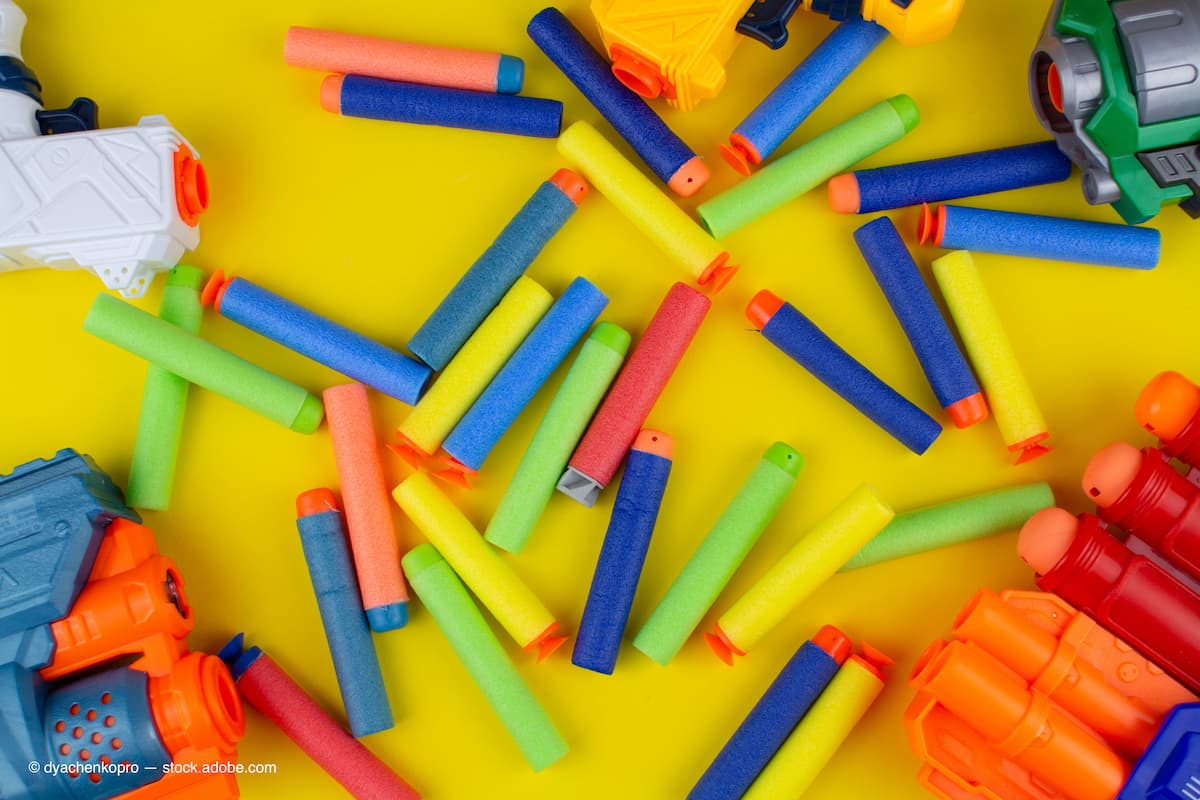Increase in toy-associated pediatric ocular injuries
Investigators reported “an increasing trend in the incidence of eye injuries associated with so-called ‘nonpowder’ guns among children.”
Alexandre Dentel, MD, and colleagues from the Ophthalmology Department, Rothschild Foundation Hospital, Paris, conducted a retrospective study to determine the annual incidence and severity of ocular injuries related to toys in one emergency department in Paris. They reported “an increasing trend in the incidence of eye injuries associated with so-called ‘nonpowder’ guns among children.”1
This study demonstrated an increasing trend in the incidence of eye injuries associated with nonpowder guns among children. (Adobe Stock/dyachenkopro)

The study involved a review of the medical records of all cases of nonpowder gun–associated trauma managed since 2010. The investigators collected the following data: the date and cause of trauma, demographics, initial and follow-up eye examinations, any surgical procedures, and visual outcomes.
They searched the database forthe following terms: foam bullets, foam darts, nerf, paintball, airsoft, BB gun, and gun.
Analysis results
From January 2010 to 2022, the investigators identified 304 patients (mean age, 16 years, range, 8 days to 74 years) more than three-quarters of whom were male who presented to the emergency department with an ocular trauma.
The study found that the toys that were most often involved in these injuries were foam projectiles from a nonpowder gun in 151 cases (50%; mean age, 15 years), BB gun or airsoft gun in 110 cases (36%; mean age, 16 years), paintball guns in 31 cases (10%; mean age, 22 years), and unspecified in 12 cases (4%; mean age, 7 years).
The data indicated that the mean age of patients with injuries from a foam projectile blaster decreased from 16 years in 2014 to 10 years in 2022 (decrease, 6.1 years; 95% confidence interval, 1.65-13.85 years; p = 0.008).
During the study period, the foam projectile blasters resulted in 2 open-globe injuries, 51 intraocular hemorrhages, 3 cataracts, 19 retinal injuries (including 2 retinal tears and 1 retinal detachment), 22 iris injuries, 12 cases of ocular hypertension, and 45 corneal lesions. One boy younger than 10 years had no light perception in 1 eye after a globe rupture associated with a foam projectile from a nonpowder gun, the authors reported.
This study demonstrated an increasing trend in the incidence of eye injuries associated with nonpowder guns among children.
A caveat regarding this trend is that the study included the COVID-19 pandemic,2 which may have interfered with epidemiological trends, they suggested, although they pointed out that “the sight-threatening potential identified from foam projectile blasters supports previous reports.3-6
The authors suggested that consumers pay attention age labeling of toys and consider use of protective goggles, while manufacturers could promote use of safety glasses to protect children’s eyes.
References
1. Dentel A, Boulander E, Vignal-Clermone C, et al. Incidence of eye trauma in children associated with foam bullets or foam darts from nonpowder Guns.JAMA Ophthalmol. Published online May 11, 2023. doi:10.1001/jamaophthalmol.2023.1464
2. Halawa OA, Friedman DS, Roldan AM, Zebardast N. Changing trends in ocular trauma during the COVID-19 pandemic in the USA. Br J Ophthalmol. 2023;107:295-298. doi:10.1136/bjophthalmol-2021-319627
3. Oydanich M, Uppuluri A, Zarbin MA, Bhagat N. Epidemiology of ocular injuries related to toy guns in pediatric patients from 2000 to 2019. J Pediatr Ophthalmol Strabismus. 2022;59(3):e29-e31. doi:10.3928/01913913-20220314-01
4. Morales NG, Hatcher JB, Padovani-Claudio DA. Eye injuries associated with nerf gun use in a pediatric population: a case series. J AAPOS. 2021;25:e41-e42. doi:10.1016/j.jaapos.2021.08.159
5. Yang U, Greer C, Kim J, Nagiel A. Ocular trauma from toy guns with foam projectiles in 4 children. Clin Pediatr (Phila). 2020;59:92-94. doi:10.1177/0009922819884573
6. Mandviwala MM, Sassani PP. Traumatic retinal detachment caused by nerf gun shot in a pediatric patient. Retin Cases Brief Rep. 2021;15:568-570. doi:10.1097/ICB.0000000000000853
Newsletter
Want more insights like this? Subscribe to Optometry Times and get clinical pearls and practice tips delivered straight to your inbox.